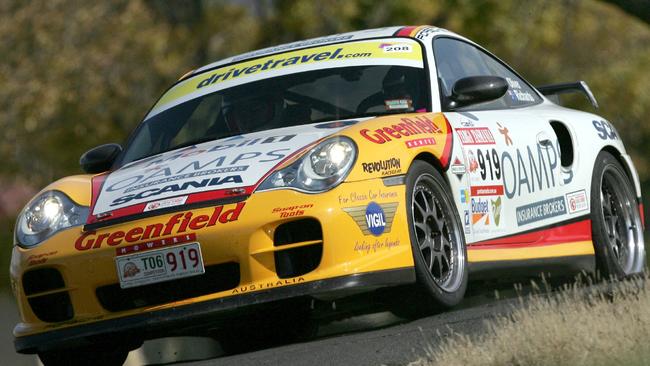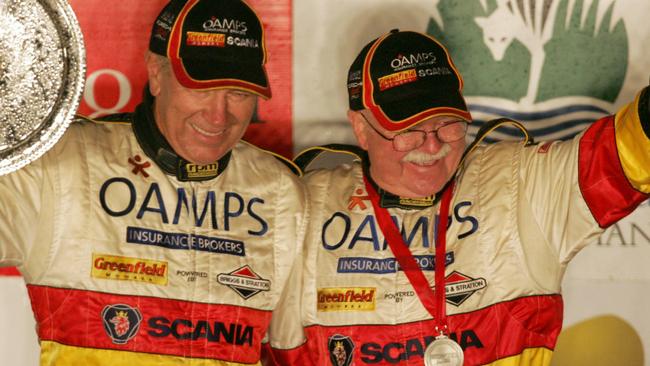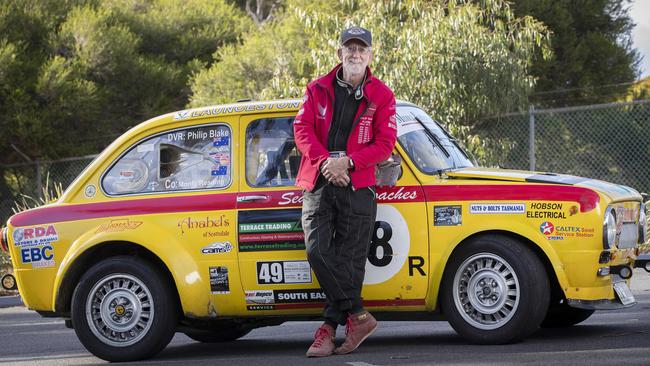‘Sh-t that was close’ The many near misses of Philip Blake on the eve of the 30th Targa Tasmania
“Sh#t that was close”. Philip Blake has fallen off a mountain, been blown out of bed by an IRA bomb, survived an armed robbery and had several close shaves in Targa Tasmania, which celebrates its 30th anniversary next week. JAMES BRESNEHAN reports >
Sport
Don't miss out on the headlines from Sport. Followed categories will be added to My News.
STANDING waist-deep in ferns looking back at a 300m trail of destruction leading to his battered car, the first thing that went through the mind of Philip Blake was “shit, that was close”.
There have been numerous hits and misses in Blake’s 25 Targa Tasmania forays, and with the 30th anniversary event starting in George Town on Tuesday all of those memories have come flooding back for the event stalwart.
A record field of 500 cars will make what is regarded as the world’s premier tarmac rally also the world’s largest tarmac event, with competitors in 10 categories tackling 2000km around Tasmania over six days.
Over three decades Targa has created heroes and villains, and attracted a cavalcade of luminaries like Hollywood star Eric Banner, golfing great Stuart Appleby, Tour de France sprint champion Robbie McEwen and the first Australian to win a TDF stage Phil Anderson, bono fide Formula One legends Sir Jack Brabham, Sir Stirling Moss and Denny Hulme, and UK’s world rally champion Roger Clark.
Victorian Jim Richards and his Tasmanian navigator Barry Oliver are the kings of Targa, having won it a record eight times, while locals Jason White and his uncle John have won seven.



Blake’s near miss on the notorious Rossarden stage wasn’t the only reason the Ireland-born 72-year-old Hobart author was inspired to write his book called, appropriately called Shit, That Was Close ($25, Forty South Publishing).
Over the journey, Blake has crashed his motorcycle, fallen off a bicycle without a helmet, fallen off a mountain and literally been blown out of bed by an IRA bomb when he lived in Belfast.
Other near misses involve logging machinery, wild animals, ice climbing, abseiling, bushwalking, explosives, a robbery, amateur mechanics, a train, aircraft, fires, white-water rafting and “adolescent foolishness”.
It’s the 140kp/h “off” at Rossarden that sticks in his mind.

Blake’s son John was driving his previous car, a Lancia, on that stage. He rounded a fast bend that turned out to be as slippery as it looked.
“He tried to correct it but he ran out of room,” Blake said. “We had a long, wild ride which felt like half an hour. On the way we jumped a drain, mowed down a small tree and hit a big rock sticking up out of the ground and ripped off all four exhausts. It was like a video game as we went through scrub about the same height as the car and everything was a blur. Finally we hit one tree and spun into another tree, which we uprooted. Then we opened the doors and walked away.”
Blake is now instantly-recognisable in his bright yellow Fiat Abarth Omologato Turismo 1600.

“It has 140 horsepower and weighs 845kg, about the same as a Ford GT40 without the 450 horsepower. But it has a very good power-to-weight ratio _ three times the power it is supposed to have,” Blake said.
Targa Tasmania started in 1992 as a cavalcade of cars, from the old to the new, with limited safety equipment required and helmets and race suits optional.
Launceston driver Greg Crick was the hero of the day, winning the first two Targas in his Honda NSX with childhood friend Greg Preece as navigator.

“It was fantastic back then. It was new to the state so there was a lot of excitement about it,” Crick said.
“We had a lot of international stars here in the first couple of years, which was great. It brought people out from everywhere. The roads were lined with schoolkids, it was a fantastic parade of cars, new and old and collectable, all sorts of beautiful cars.”
Going back-to-back was a combination of the Honda supercar, local knowledge and the partnership with Preece.
“A lot of people turned up with cars set up as race cars and they just don’t work on normal roads,” Crick said.
“I had a usable car and a bloody good navigator. He’d done a lot of rallying. We grew up together. I lived at Perth and he lived at Longford, we played footy together at Longford and we’d known each other all our lives. So we had a good relationship, I trusted him and he trusted me and we got along really well and it worked. You can’t win unless you’re a team.”

Over the 30 years, five men have died doing what they love in Targa, including a heart-breaking three deaths in one event last year.
NSW driver Shane Navin died after losing control of his car on the Mt Arrowsmith stage on the state’s West Coast, and the next morning Leigh Mundy, 68, of Hobart, and his co-driver Dennis Neagle, 59, of Withcott, Queensland, were killed when their Porsche 911 crashed into a tree near Cygnet.
After an independent investigation, Targa Tasmania’s world-standard safety measures were tightened further, with 17 new requirements to make driver licensing more strict, car set-ups more rigorous and the fastest stages slower.
“Targa Tasmania is the real thing. It’s real motorsport in a way that circuit racing isn’t,” Blake said.
“You race in real roads with the real hazards of real roads. This year there aren’t as many hazards because after last year things have been made safer. There are now a lot of places where we have to slow down where we would have been going flat-out, and that’s probably for the best.”



